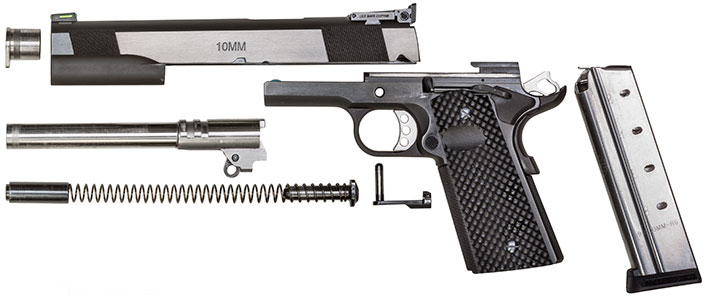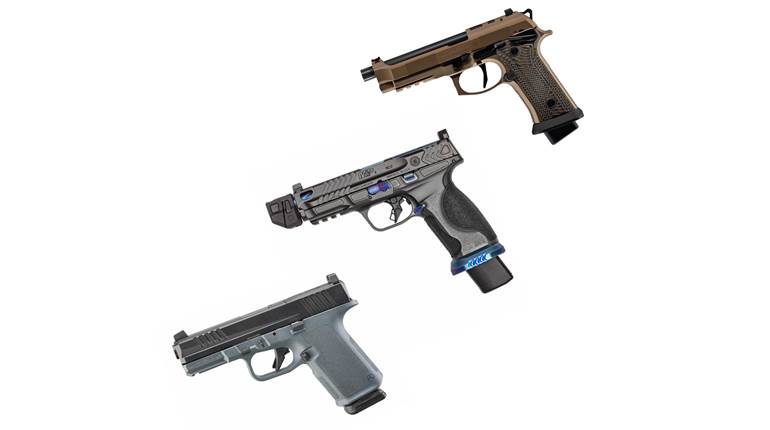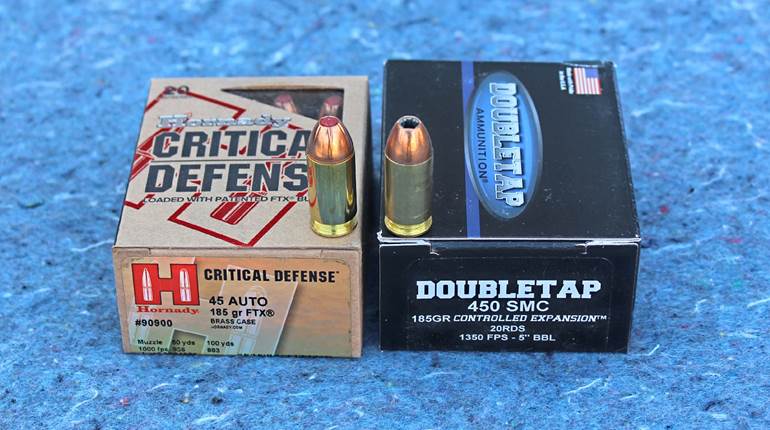
Thunder Ranch Special 2nd Gen (l.), Premier II 6" 10 mm Hunter (r.)
It gives a gun writer pleasure to have new guns to test. And it provides him extra joy when they are nice, well-made guns. Such was the case, recently, when two M1911 pistols arrived in my part of the Southwest from Les Baer Custom. I knew that this was going to be an enjoyable assignment.
Les Baer Custom started doing business in 1991, at Hillsdale, Ill. And it is the mark of the man that Baer’s guns quickly developed a reputation for quality. Les has set that standard for himself, and he expects the same quality out of those who work for him. He’s sort of bull-headed that way. Speaking of bull-headed, a few years ago, Les got fed up with the silly gun regulations in Illinois and moved his business to a more gun-friendly environment. Nowadays, Les Baer Custom builds M1911 pistols and AR-style rifles out of his shop in Le Claire, Iowa.
Some years back, Baer and defensive firearm instructor Clint Smith got together and designed an M1911 pistol along the lines of what Smith thought a fighting pistol ought to be. Baer has also kept his eyes on the market enough to know that the 10 mm Auto cartridge is well on its way to a comeback. So who better to make a super-accurate M1911-style hunting pistol than Les Baer? Together, they represent the best from one of America’s greatest pistolsmiths.
The Fighter
I’ll tackle the first of the Baer M1911s that arrived for my evaluation head-on since it’s designed for exactly the kind of trade in which I used to engage. It is a .45 ACP called the Thunder Ranch Special (TRS) 2nd Gen and differs only slightly from the original version, adding some features that defensive pistol shooters will like and have undoubtedly asked for in the past.
The most obvious difference is that the new pistol’s frame is chromed, while the slide is blued. The slide is topped off with an fixed combat rear sight and a post front sight, both of which have tritium inserts for low-light shooting. Bilateral thumb safeties are standard-issue, and the very attractive stocks are standard-thickness cocobolo with the Thunder Ranch logo on them.

As with the earlier TRS pistol, this new gun features a 5" match barrel and flat mainspring housing. The front of the slide has forward cocking serrations that are popular with today’s pistol shooters. The mainspring housing and frontstrap are nicely checkered. The M1911 is shipped with two eight-round magazines.
While on the subject of features, I should mention that after I turned in this story, Les Baer advised that he had decided to cease production of the Thunder Ranch models, but he still offers the nearly identical Ultimate Tactical Carry and Custom Carry.
When working with a new pistol, I like to first test the gun for accuracy. With that in mind, I loaded up my PACT chronograph and an assortment of .45 ACP ammunition that I happened to have on hand. It is no accident that the ammunition was all of the 230-gr. variety, because that is my personal choice and recommendation for defensive use.

Setting up a target at 25 yds., I rested the TRS on some sandbags and settled down to see what it would do. The best average of five, five-shot groups was obtained with the Black Hills 230-gr. JHP load, managing 2.03". However, the Remington and Federal loads weren’t far behind the Black Hills load at all. The clean-breaking 4-lb. trigger of this Les Baer gun was a real asset to accurate shooting. For what it’s worth, that Black Hills load gave an average velocity of 849 f.p.s., the Remington 230-gr. JHP was fastest, coming in at 941 f.p.s., and the Federal 230-gr. FMJ rounds split the difference at 862 f.p.s.
Following the accuracy work, I set up some silhouette targets and got ready to have some fun. From 10 yds., I worked on delivering controlled pairs to the vital zone of the Gunsite Option target. The front sight was quick to acquire, and the clean-breaking trigger made this fairly easy work.
Moving up to 7 yds., I worked on Col. Cooper’s Failure Drill. This drill assumes that you have delivered two hits to the vital zone and, for whatever reason, your attacker is still coming. The proper response is to then deliver one shot to the head to stop the action. The shooter generally has to slow down a bit and deliver this shot with a bit more precision. That’s where the excellent sights and trigger on this TRS really helped me out. The final testing was done shooting off-hand at 25 yds. The pistol again delivered its payload to the vital zone of the target.

Having had a great deal of experience with the first generation of Baer’s Thunder Ranch guns, I can’t say that this 2nd Gen gun really surprised me all that much. I expected it to be an attractive pistol that shot and functioned accurately and reliably. And it was just that—good looking, accurate and reliable. It and its current equivalents, the Ultimate Tactical Carry and Custom Carry, are all pistols you could bet your life on.

The Hunter
The second Baer pistol I received for evaluation was the Premier II 6" 10 mm Hunter. I must admit that I don’t have a lot of experience with 10 mm Autos, a flaw that my shooting buddy Bart Skelton has continually pointed out to me. Bart is a dyed-in-the-wool 10 mm Auto fan. He likes the cartridge for hunting, and he has packed several 10 mm guns during his law enforcement career. So, I sincerely hope that he is reading this and will cut me a little slack because I was impressed with this big M1911, and I had a lot of fun shooting it.
The Hunter, in the resurgent and highly regarded 10 mm Auto cartridge, is indeed a big gun, sporting a 6" match barrel with a supported chamber, weighing in at slightly over 44 ozs. The Hunter has a fully adjustable rear sight and a green fiber-optic front sight standard, though a red version is optional. The trigger is a 4-lb. Speed Trigger. The gun has a single, extended, Combat Thumb Safety and black VZ Recon synthetic stocks. The frontstrap of the grip frame is checkered, while the mainspring housing is serrated. Two nine-round magazines come with each pistol.

At the range, working again from sandbags at 25 yds., I tested this 10 mm Auto pistol with three different bullet weights. The most accurate load that I ran through the gun was the Winchester 175-gr. Silvertip hollow-point round, giving an average of 2.05". The fastest round was the Federal 180-gr. jacketed-soft-point load at 1312 f.p.s. As you can see from the accompanying table, accuracy was good with all three loads.
Running through some speed work and field shooting, I found that the extra inch of barrel and slide simply didn’t matter as far as the balance and feel of the gun were concerned, and the longer sight radius was definitely a plus. The trigger was also clean, breaking at 4 lbs. And the recoil of this 10 mm pistol wasn’t anything to be worried about; it was far more comfortable for me to shoot than the average .41 Mag. double-action revolver.
After working out on some of the same defensive drills that I ran with the TRS, I settled down to bust some dirt clods off the 50-yd. berm. While certainly an unscientific test, it was, however, quite pleasing and indicative of the value of this 6" pistol as a hunting gun.
I really prefer that the rear sight of a pistol be black. However, I do like to have something on the front sight that draws my attention to it. Ordinarily, I use a gold bead on the front sight, but I have to say that this green, fiber-optic front sight was certainly fast to get on target and helped me keep my focus on it, which, in pistol shooting, is really important for accurate work. It was also a bit quicker for me to acquire during fast shooting.

Sadly, our hunting seasons were closed during the time that I had the Premier II for testing. I am convinced that it would be no challenge to ethically harvest deer, turkey and javelina with the pistol. But, quite frankly, I also think it would do a number on feral hogs and black bear, both of which can run off while packing a lot of lead. Of course, the 10 mm Auto, with the proper bullets, has already done all of that, and collected a lot of African game, besides.
Okay, so I have to admit that Bart Skelton is right. A 6"-barreled 10 mm handgun is an impressive piece of ordnance. And I’ll just have to see if I can get my hands on another one between now and when our next hunting season rolls around. The Les Baer Premier II has convinced me.
With so many different companies offering M1911 pistols, the shooter, especially the beginner, often wonders why he should pay more for a gun like those that Les Baer builds. The secret is in the guns themselves.

There is no magic involved in building an M1911 that is both accurate and reliable. But there is a formula that must be followed if one is to truly create a good gun. Begin by only using quality material, in this case forged steel for all of the major parts. Then fit those parts to very close tolerances—in other words, as precisely as possible. The barrel, slide and frame all have to fit tightly, with lots of smooth contact surfaces. You simply can’t slap stuff together and hope that it works, because it usually won’t.
Les Baer is one of a handful of M1911 craftsmen who take the time to build guns right and expect them to last. For many years, he personally test fired every firearm that his company produced. I’ve lost track of how many Les Baer guns that I’ve fired over the years, but, without exception, I have found them to be accurate and reliable handguns—the kind of pistol a man could bet his life on.







































